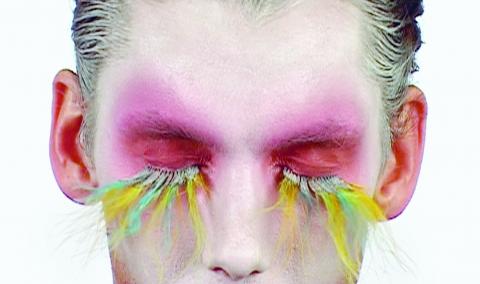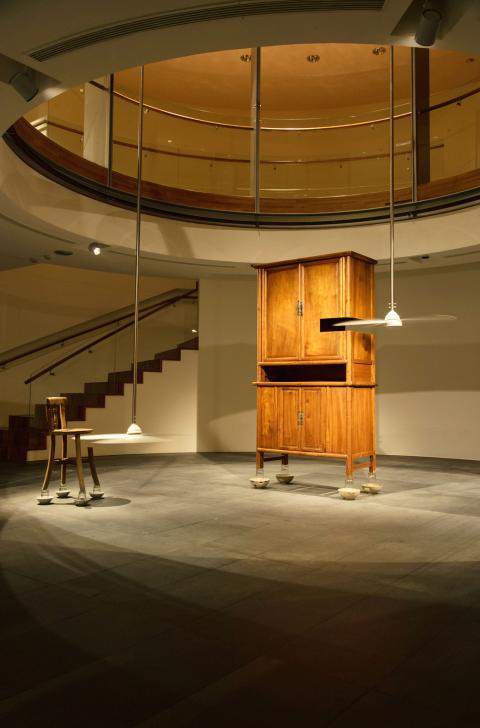At Vertigo: Chaos and Dislocation in Contemporary Australian Art (迷魂場域), 10 Australian artists bring works about the stranger conditions of contemporary life. Using motion sensors, Kristin McIver builds an installation that greets passersby with urgent demands to “share” and “engage” online — a parody that attracts notice to a routine event. Cate Consandine’s Lash is a video without a narrative about the fetish of cosmetics and masks, featuring a man with feathers attached to his face. Curated by Claire Anna Watson, Vertigo is a touring exhibition organized by Asialink Arts in Australia. It is named after the Hitchcock film Vertigo, notable for using the in-camera dolly zoom effect to convey the protagonist’s fear of heights.
■ Museum of Contemporary Art, Taipei (MOCA, Taipei), 39 Changan W Rd, Taipei City (台北市長安西路39號), tel: (02) 2552-3720. Open Tuesdays to Sundays from 10am to 6pm. Admission: Free
■ Opens tomorrow. Until June 8

Photo Courtesy of MOCA
Chen Shun-chu (陳順築) presents his memoirs in two ways at solo exhibition One Piece Room. Born in 1963 in Penghu County, Chen left as a teen to live in Taipei and pursued what became a successful career as a fine art photographer. Fengkuei Chair (風櫃椅), a two-part installation, is his careful configuration of a wooden cabinet, a rotating ceiling fan, a chair, a glass of water and other household items. Each is a symbol — the cabinet is home, the chair is himself and the objects are memories — and their arrangement depicts an inner emotional tension that comes with a nomadic career. At the exhibition Chen is also showing On the Road (迢迢路), 11 black-and-white images that prominently feature puddles on the road and desolate, unpeopled street scenes in Penghu, Taiwan and a handful of foreign countries. These road landscapes are left unprocessed and uncut, so that they are an unedited scrapbook of time spent between destinations.
■ Kuandu Museum of Fine Arts (關渡美術館), 1 Xueyuan Rd, Taipei City (台北市學園路1號), tel: (02) 2896-1000 ext 2432. Open Tuesdays to Sundays from 10am to 5pm
■ Opens today. Until July 6

Photo Courtesy of TFAM
The Youth Innovative Design Festival (青春設計節) at the Pier-2 Art Center in Greater Kaohsiung is an annual stage for Taiwanese students of audiovisual media, digital technology, visual design, games and installation art. This year, the program includes a film festival and forums by design professors and working designers. For more information, visit www.ydf.org.tw
■ Pier-2 Art Center (駁二藝術特區), 1 Dayong Rd, Greater Kaohsiung (高雄市大勇路1號), tel: (07) 228-8936. Open Tuesday to Sundays from 10am to 8pm, admission: NT$99
■ Until Sunday
Pioneer of Taiwan Ceramics (臺灣窯業達人) features Lin Ken-Cheng (林根成) — “Teacher Ah-cheng” (阿成師) — an octogenarian who was the face of Taiwanese ceramics at the 1962 World’s Fair in Seattle. His solo exhibition is a roundup of iconic works including his sophisticated statues of Buddha and other gods, which were exported to about 40 countries throughout his career. Born in Tonghsiao (通霄), Miaoli in 1932, Lin is founder of Yingge’s Chuohong Studio (佐弘工藝社工作室) and the Taiwan Folk Art Ceramics Company.
■ Yingge Ceramics Museum (鶯歌陶瓷博物館), 200 Wenhua Rd, New Taipei City (新北市文化路200號), tel: (02) 8677-2727. Open Mondays to Fridays from 9:30am to 5pm, Saturdays and Sundays from 9:30am to 6pm, closed first Monday of the month. Admission: Free
■ Until June 8
Playground for Kids: Indigenous Contemporary Art of Taiwan (童年遊戲場: 臺灣原住民當代藝術展) is an interactive art show for children at the Kaohsiung Museum of Fine Arts (高雄市立美術館). Eight artists from six Aboriginal tribes were invited to create pieces that teach children the Austronesian games and customs of their own childhoods. There’s a theater that screens animated films, as well as interactive pieces such as a kid-friendly loom for Atayal weaving and a “forest” populated with animal sculptures, where children can learn creative uses for the leaf of a pandanus tree.
■ Children’s Museum of Art Gallery at the Kaohsiung Museum of Fine Arts, 80 Meishuguan Rd, Greater Kaohsiung (高雄市美術館路80號), tel: (07) 555-0331. Open Tuesdays to Sundays from 9am to 5pm. Admission: Free
■ Until May 25

In the March 9 edition of the Taipei Times a piece by Ninon Godefroy ran with the headine “The quiet, gentle rhythm of Taiwan.” It started with the line “Taiwan is a small, humble place. There is no Eiffel Tower, no pyramids — no singular attraction that draws the world’s attention.” I laughed out loud at that. This was out of no disrespect for the author or the piece, which made some interesting analogies and good points about how both Din Tai Fung’s and Taiwan Semiconductor Manufacturing Co’s (TSMC, 台積電) meticulous attention to detail and quality are not quite up to

April 21 to April 27 Hsieh Er’s (謝娥) political fortunes were rising fast after she got out of jail and joined the Chinese Nationalist Party (KMT) in December 1945. Not only did she hold key positions in various committees, she was elected the only woman on the Taipei City Council and headed to Nanjing in 1946 as the sole Taiwanese female representative to the National Constituent Assembly. With the support of first lady Soong May-ling (宋美齡), she started the Taipei Women’s Association and Taiwan Provincial Women’s Association, where she

Chinese Nationalist Party (KMT) Chairman Eric Chu (朱立倫) hatched a bold plan to charge forward and seize the initiative when he held a protest in front of the Taipei City Prosecutors’ Office. Though risky, because illegal, its success would help tackle at least six problems facing both himself and the KMT. What he did not see coming was Taipei Mayor Chiang Wan-an (將萬安) tripping him up out of the gate. In spite of Chu being the most consequential and successful KMT chairman since the early 2010s — arguably saving the party from financial ruin and restoring its electoral viability —

It is one of the more remarkable facts of Taiwan history that it was never occupied or claimed by any of the numerous kingdoms of southern China — Han or otherwise — that lay just across the water from it. None of their brilliant ministers ever discovered that Taiwan was a “core interest” of the state whose annexation was “inevitable.” As Paul Kua notes in an excellent monograph laying out how the Portuguese gave Taiwan the name “Formosa,” the first Europeans to express an interest in occupying Taiwan were the Spanish. Tonio Andrade in his seminal work, How Taiwan Became Chinese,